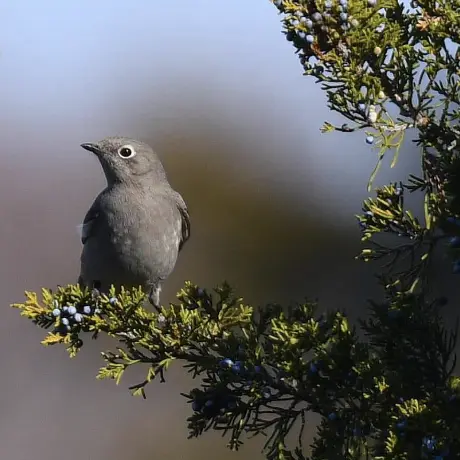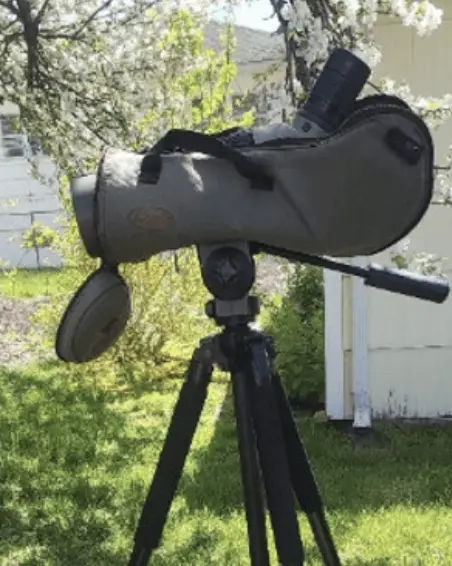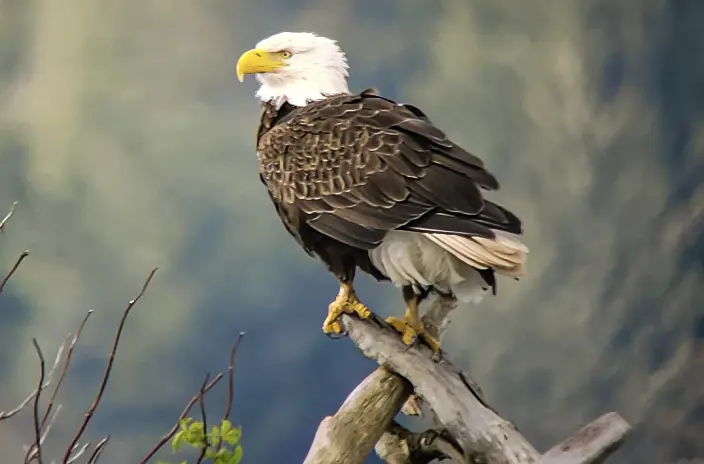By Frank Gallo
Spotting scopes allow you to see objects at greater distances than binoculars and are designed for birding and hunting. If you spend a lot of time looking at birds at great distances such as migrating hawks, shorebirds, ducks, and other waterbirds, or want closer views of any bird, spotting scopes can be quite useful. They do require a tripod and can be heavy to carry around. Carbon fiber tripods significantly lighten the load but are expensive.
Spotting scopes come with either a fixed eyepiece, usually a 20, 25, or 30x wide angle, or with a zoom usually 15-45x, 20-60x, or 25-70x. Before modern optical coatings were widely available, fixed eyepieces were the norm, but now, with newer coatings and lens manufacturing techniques, the more versatile zoom eyepieces are preferred by most birders. The image quality remains useable even at the highest magnification with good quality brands.

Spotting scope objective lens sizes vary from 55 mm to 115 mm. 77-90mm objective lens are quite popular sizes but choose the objective lens size that fits your needs. Scopes with smaller objective lenses, 55-66 mm are compact, light, and great for traveling. They perform well under most circumstances but may fall short in low light. Scopes with larger objective lenses gather more light, providing clear bright images even in low lighting where smaller scopes would struggle. Larger objective lenses do add bulk and weight. Consider your needs. Are you willing to carry it? You’ll have binoculars. Do you also carry a camera when birding? Many people bird near their vehicle so the weight of a larger scope is not an issue.
Kowa and Swarovski are considered by many to be the leading brands for spotting scopes. Zeiss and Leica also make excellent scopes.
Kowa scopes have a dual-focus system, allowing for precise focus, compact lightweight magnesium alloy bodies, and most importantly models have pure fluorite crystal glass which provides an exceptionally sharp edge to edge image! They are weather and fog proof.
Swarovski scopes have a single focus on the barrel allowing for easy focusing while wearing gloves or mittens, have excellent image quality, are sharp edge to edge, and are weather and fog proof. They make a modular system so objective lenses can be swapped.
If you go birding on your own predominantly, straight scopes make it simpler to sight on a bird. Angled scopes are easier to use with a group, making it unnecessary to constantly adjust the height of the scope for different people.

Adaptors are available for use with phones or cameras effectively creating a long telephoto lens.
Price Ranking (from highest to lowest)
1. Swarovski: Known for their premium quality and high prices, that range from around $2,000 to over $5,000 depending on the model and configuration. The new ATC 17-40×56 A Scope is compact and lightweight for those who travel a lot. $2700. Good customer service.
2. Zeiss: Offers high-end models with excellent optics. High-end models like the Victory Harpia range between $2,000 and $4,600
3. Leica: Provides top-notch optical performance at a premium price. The APO-Televid series ranges from $2,500 to $4,000.
4. Kowa: Known for great optical quality at a slightly lower price point. Prices vary widely, with high-end models like the TSN-883 costing between $2,000 to $3,000. If you are looking for lightweight, the new TSN 55 & 55A is tiny, but mighty. $2000. Good customer service with fast repair times.
5. Vortex: Offers good quality at more affordable prices, with models like the Razor HD series priced between $1,000 and $2,400. Their Diamond series is good for beginners at under $500 but gives up some clarity and brightness. The edge-to-edge clarity tends to decrease slightly with increased magnification from 20-60x.
6. Vanguard Endeavour HD (20-60x): Offering good performance in low light conditions, this scope is considered a solid choice under $750. As with all less expensive models, the edge-to-edge clarity tends to decrease slightly with increased magnification from 20-60x.
7. Celestron Regal M2 80ED (20-60x): Another solid choice under $1000, it has extra-low dispersion glass with Celestron’s proprietary XLT optical coatings which help to maximize brightness. The edge-to-edge clarity tends to decrease slightly with increased magnification from 20-60x. Comes with a limited lifetime warranty. $780.

Each brand has its strengths and weaknesses, and the choice depends on your specific needs and budget. At $1500 or less, consider buying a used higher-end model for a similar price. Optics and construction are generally better.
Where to try and buy Spotting Scopes locally: Both the Audubon Shop in Madison and Fat Robin in Hamden have knowledgeable staff, offer a wide range of optics, and allow you to test spotting scopes on site. The Audubon shop also sells used equipment, making it possible to get higher end spotting scopes at a reduced cost. Of course, spotting scopes can also be purchased online, but if you use local expertise to choose a scope, I recommend purchasing from them.

